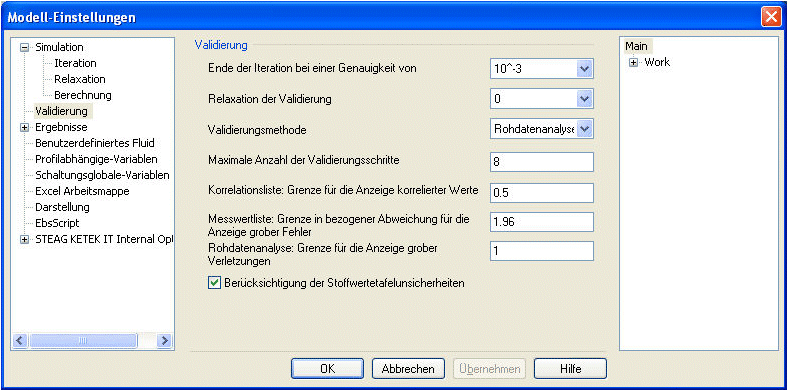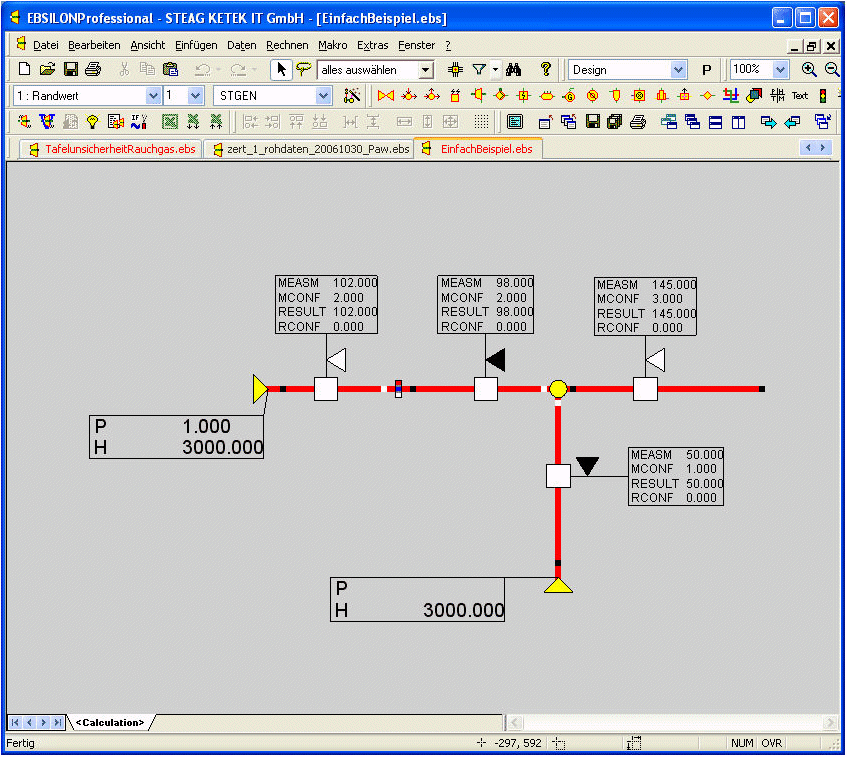

Since the correctly formulated auxiliary conditions must be fulfilled by the true values without contradiction, further useful tips for the error analysis can be obtained from the violation of the auxiliary conditions through the raw data. If no convergence problems occur, the balanced data must fulfill the auxiliary conditions without any contradiction. The balanced data are to be included for the further evaluation.
EBSILON®Professional offers the possibility to cover the balance violations in the simulation mode itself. However, in this case only the amount of the violation is determined and not its confidence interval, so that an evaluation as per VDI 2048 is still not possible.
In order to get the confidence interval also for the violations, a complete validation calculation is necessary, in which the measured values are made fixed and the balance equations are fulfilled only approximately. This calculation mode is enabled under "Extras"à"Model Options" at "Validation" under "Validation method" (setting "Raw data analysis").
The value "Raw data analysis: Limit for displaying broad violations" is to be set to 1, in order to display the broad violations in the sense of the guideline. These are auxiliary conditions, whose deviation is greater than their confidence intervals. The probability that a violation is present, is > 95 % in this case.

The evaluation of the raw data analysis is done with the help of the equations list, which can be enabled under the menu "View".
The following simple example shows the relationship:

This model represents a simple mixing. There are two mass flow measurements on a feed line. For doing a raw data analysis, one must in this case cut open the line and install a separator, which one sets to FSPEC="none", so that in the simulation mode it does not act as a separator, but instead sets all the parameters at the outlet the same as those at the inlet.
If one restricts to mass flows, there are two balancing equations in this model, namely the mass balance of the mixing M1+M3-M2=0 and the mass flow of the separator M2-M1=0.
After the raw data analysis one gets the following result in the equations list:

This means that a broad violation is present only in case of the separator. On the other hand, the violation at the mixing is not to be considered as "broad".
If one reduces the threshold for the display to 0.5, then the following equation is also shown:

One can see that there is no broad violation of this equation, because the confidence interval of 3.7417 is greater than the deviation of 3.0 i.e. the deviation lies within the interval of -0.7417 and +6.7417 with a probability of 95%. The value "0", therefore, still lies within the confidence interval.
After conducting the raw data analysis, the entry "Validation method" must be reset to "VDI 2048 EBSILON". In this calculation mode the auxiliary conditions are kept fixed and the measurement values vary. As result one gets the balanced data for all the measurement values including their confidence intervals.

Further evaluations on the basis of balanced data are done better with the script language "EbsScript" integrated in EBSILON®Professional. With such a script one can automate the entire run of the calculation. There is an access to all values, which are available in the model (defaults and result values) and one can start all kinds of calculations. For evaluations on the basis of balanced data after the validation, the command
transferValResults
is available, which imports the validation results in a sub-profile as default values.